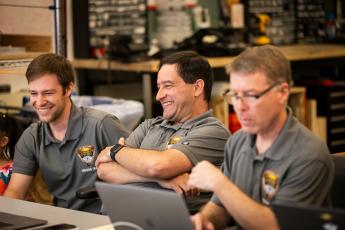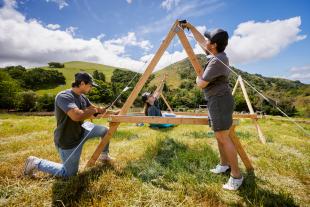NASA Chooses Cal Poly to Help Develop New Technology for Lunar Exploration Missions

Cal Poly is teaming up with NASA and nine other university teams across the nation to advance small spacecraft technologies that will help pave the way for human and robotic lunar exploration.
“Cal Poly’s CubeSat Lab has a history of collaboration with a number of different NASA centers,” said John Bellardo, who directs the lab — the campus epicenter for the class of small satellites, which are about the size of a loaf of bread. “These awards are further evidence of that. I expect these opportunities to continue into the future.”
NASA’s Artemis lunar exploration program aims to return men and women astronauts to the moon by 2024. “SmallSats” — spacecraft that range from the CubeSats that Cal Poly helped turn into an industry standard up to larger satellites the size of a refrigerator — will help blaze the trail.
While small satellites mainly operate in low-Earth orbit, those with an altitude of up to 1,200 miles (2,000 km), technological advancements through these collaborative partnerships will more fully realize their potential as they extend the capabilities needed in complex lunar exploration missions.
“As we prepare for the next robotic and crewed missions to the moon, we expect small spacecraft to help forge the path ahead by scouting terrain, prospecting for resources and establishing communications and navigation capabilities in cislunar space,” said Christopher Baker, program executive for NASA’s Small Spacecraft Technology program. “Taking advantage of their small size and shorter development timelines, small spacecraft are increasingly capable as both rapid precursor missions and as cost-effective, in-space infrastructure.”
SmallSats could provide exploration missions with communications relays or navigation services at the moon, similar to role that communications and GPS satellites play around Earth. This capability could play an important role in helping NASA build a sustainable presence on the moon.
The NASA program selected the university teams for its SmallSat Technology Partnerships initiative to mature new systems and capabilities. The technology development projects focus on three technical areas needed for lunar-bound missions:
- Use of small spacecraft to help provide lunar communications and navigation services
- Small spacecraft propulsion for lunar missions and potential return of lunar samples using small spacecraft
- Small spacecraft electrical power and thermal management systems tailored for the distant and harsh environment between Earth and the moon
In addition to Cal Poly, the other selected California schools are: California State University at Los Angeles; San Diego State University, UCLA; and UC Irvine. The remaining universities are: Arizona State University, Tempe; University of Colorado, Boulder; University of Illinois, Urbana-Champaign; University of Texas, Austin; and Utah State University, Logan.
Cal Poly will participate in a pair of two-year projects, both in collaboration with NASA’s Jet Propulsion Laboratory in Pasadena, California. The grants are valued at $200,000.
The first, under the SmallSat Propulsion for Lunar Missions area, will team Cal Poly with UC Irvine for a project titled “Variable Specific Impulse Electrospray Thrusters for SmallSat Propulsion.”
The project will build on existing propulsion technology that uses electrostatic charges to propel liquid droplets to generate thrust. It will further develop and test a more-versatile system capable of operating in either a high-thrust mode when needed, or more efficient low-thrust mode to conserve fuel and save weight. This technology will add mission flexibility to electrospray propulsion systems while keeping within the size suited constraints of small spacecraft.
“Cal Poly will be providing a design for a CubeSat to test the thrusters, including an electrical subsystem that is capable of powering the thrusters,” Bellardo said. “UCI will be focusing more on the thruster side. Cal Poly will be focused on the spacecraft side.”
The second proposal, under NASA’s Advanced Electrical Power Subsystem and Thermal Management Technology area, pairs Cal Poly with Cal State Los Angeles for a project titled “An Additively Manufactured Deployable Radiator with Oscillating Heat Pipes to Enable High Power Lunar CubeSats.”
Compact CubeSats do not efficiently dissipate heat, yet lunar missions will demand even more electrical power, which produces heat as a byproduct that could damage core components of a small satellite. The equipment needed for longer duration missions far from Earth orbit includes more powerful radio transmitters while simultaneously dealing with the harsh cislunar thermal environment. The grant will fund the development of a deployable radiator with flexible oscillating heat pipes to provide more efficient heat transfer than traditional thermal straps.
“The more power a spacecraft needs, the more heat gets generated — both during power generation and consumption,” Bellardo said. “Radiators are part of the solution to keeping the spacecraft cooler. The technology is applicable to other small spacecraft as well.”
Jim Cockrell, chief technologist for the Small Spacecraft Technology program, said partnerships between academia and NASA “help cultivate the rapid, agile and cost-conscious small spacecraft approaches that are evolving in the university community, as well as increase support to university efforts and foster a new generation of innovators for NASA and the nation.”
Moreover, he added, these relationships will also give the space agency “access to the bright minds who will one day lead the journey of exploration.”
The SmallSat Technology Partnerships initiative has four primary objectives: develop needed SmallSat technologies for NASA; engage university students in real-world SmallSat projects; provide student teams with NASA expertise and facilities; and allow NASA engineers to gain insights into the innovative and rapid development paradigm typical of academia. The program has made five rounds of these awards since 2013. Projects are awarded in amounts up to $200,000 to the university team for up to two years in collaboration with a half-time NASA collaborator per year.
Managed by NASA’s Ames Research Center in California’s Silicon Valley, the program expands U.S. capability to execute unique and more affordable missions through rapid development and in-space demonstration of capabilities for small spacecraft that are applicable to exploration, science and the commercial space sector. It enables new mission architectures through the use of small spacecraft while seeking to expand the reach of small spacecraft to new destinations and challenging new environments.
Cal Poly has been at the forefront of small satellite development. CubeSat is a worldwide standard for small satellites originally developed 20 years ago as a collaboration between Cal Poly’s CubeSat Lab and Stanford University. CubeSats give students the opportunity to design, build and launch small satellites into space.
What began as a vehicle for students has been embraced by space agencies, industry, governments and amateur developers across the globe. Hundreds of CubeSats have been launched including nearly dozen built by Cal Poly students.
Bellardo was part of the team that made history last July during the LightSail 2 mission. The Planetary Society, which has partnered with Cal Poly on its two LightSail CubeSats, successfully proved the concept of solar sailing by raising the orbit of the footlong satellite. Bellardo was part of the mission control team that sent radio commands from Cal Poly’s ground station to the craft orbiting 720 kilometers above Earth to unfurl its Mylar sail.
In addition, during the 2018-19 school year alone, the Computer Science professor and his team of 80 students, faculty and staff launched a trio of homegrown Cal Poly satellites and also assisted with the twin MarCO satellites, the first CubeSats to leave Earth’s orbit as a part of the InSight Mars landing mission. The six-unit MarCO pair were briefcase sized satellites that traveled for six months to provide radio relay during a flyby of the Red Planet.
Main photo caption: The Planetary Society's LightSail 2 mission team, including professor John Bellardo, deploys the spacecraft's solar sail in July 2019. Bellardo heads the university's CubeSat Lab, which will work with teams from nine other universities to advance small spacecraft technologies.




